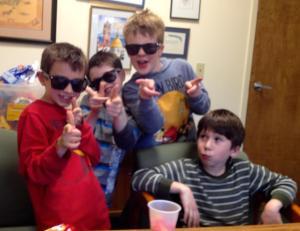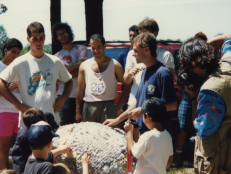A few years ago, I was going through some kids’ files and noticed a pattern in the results on the Wechsler Intelligence Scale for Children or WISC. The WISC is a commonly used test of cognitive functioning consisting of 10 subtests, which yields a full scale IQ, as well as 5 indexes that provide scores in more specific aspects of functioning, including Verbal Comprehension, Visual-Spatial Reasoning, Fluid Reasoning, Working Memory, and Processing Speed. I noticed that for many of the children attending groups at Academy MetroWest, the Processing Speed Index scores were significantly lower than the other index scores and I started to wonder why. Soon it dawned on me that there would seem to be an obvious connection between processing speed and social skills. I thought of all the auditory and visual processing inherent in ordinary, everyday, social interactions. Think about having a conversation with someone and all the cognitive tasks involved in it. You need to screen out background noise and stimulation, attend, listen to and determine the concrete meaning of the words being spoken, interpret non-verbal cues such as body language, facial expression, tone of voice, context, the perspective of the speaker, and others, while simultaneously formulating a sensible, appropriate response that conveys the meaning you wish to convey. All of this happens fast – almost instantaneously – and repeatedly over the course of just one conversation. When you think of all the “micro-tasks” involved, it’s miraculous that any of us can do it.
Since arriving at my hunch, I’ve shared it with a number of parents and professionals. I’ve made a special point to discuss it with parents when their kids have been found to have slow processing speed. In direct work with kids, knowing a child’s processing speed is helpful in understanding their social behavior and in offering useful feedback. In sharing my hunch about processing speed, I had only one problem: I had no idea if anything I was saying was actually true.
It was with this uncertainty in mind that I recently read Bright Kids Who Can’t Keep Up, by Ellen Braaten and Brian Willoughy. Drs. Braaten and Willoughby are neuropsychologists at the LEAP Program at Massachusetts General Hospital. Their book draws upon research and the authors’ extensive clinical experience to provide a vivid, insightful picture of the effects that slow processing speed can have on children’s cognition, academics, family life, and emotional functioning. It’s an excellent book that’s well worth reading. For me, it would have been enough if all it had done was to assure me that I haven’t just been talking nonsense to my clients for the last 5 years. It did that but it also accomplished much more.
Processing speed has not become a sexy subject in the way that ADHD, Autism Spectrum Disorders, and Anxiety have. But it’s going to. Taken by themselves, processing speed deficits do not constitute a diagnosis or a mental disorder. However, slow processing speed figures prominently in all of those disorders and can make many aspects of life an uphill climb for many people. According to the authors, processing speed “refers to a complex process and so is defined and measured in many ways. It also can’t be understood in isolation from other areas of thinking such as language, memory, or attention.” Because processing speed deficits are intertwined with so many other cognitive processes, its effects on an individual’s functioning can be very pervasive. For a powerful illustration of this, take a look at this video by Richard Lavoie. It poignantly illustrates the day to day experience of kids with learning disabilities in general and, although it’s not specifically mentioned, processing speed in particular:
Because these effects are described with such clarity and purpose in Bright Kids Who Can’t Keep Up, the book becomes relevant and potentially invaluable to families struggling with a host of issues. In this regard, Bright Kids Who Can’t Keep Up reminds me of Quirky Kids, by Perri Klass and Eileen Costello, another wonderful book on child development. . Both books, by describing problems that cut across labels, provide a more comprehensive understanding of children than do most books that focus on just one.
Bright Kids Who Can’t Keep Up is divided into 3 sections. Part One provides an overview of the concept of processing speed. It gives a good description of what processing speed is, how it’s assessed, and how it affects daily life. The next section goes into more detail about slow processing speed and the challenges it presents to life at home, at school, and with socializing. For each of those areas of functioning, the authors present some excellent suggestions for parents to help maximize success for their children with slow processing speed. They provide downloadable questionnaires to help parents collect more information about their child’s processing speed, the effects it may have on social skills, as well as their emotional functioning as it relates to processing speed. The third section of the book ties everything together by printing excerpts from 2 neuropsychological evaluations and offering clarification on terms found within the reports.
The recommendations found in Bright Kids Who Can’t Keep Up go beyond those found within most parenting books. As I was reading it, I found myself enthusiastically saying “YES!” in response to many of the observations and recommendations. I’m betraying a bias and perhaps being a tad self-serving in writing this but the quality of their recommendations and insights comes from not only being up on the latest research, but also from the authors’ many years of clinical experience sitting and just being with kids.
My only criticism of Bright Kids Who Can’t Keep Up is that I wish the authors had gone a little bit deeper in the third section of the book. It was helpful having excerpts from neuropsychological evaluations included in the book but it would have been even better had the authors devoted more space to fleshing out the tests, the test results, and the terminology. I found the instances in which they did to be the most valuable passages in the book and the final product would have been even better with more of that. On the whole, this is only a minor shortcoming in a book that I recommend highly to both parents and professionals. Processing speed hasn’t quite attained the status of a “hot topic” in the world of human services but I have no doubt that it will. This book is ahead of the curve and a great read.
























